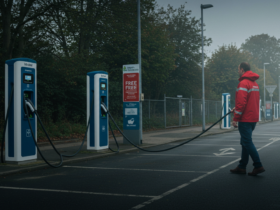As we approach the year 2025, one of the biggest problems car owners encounter is how to maximize fuel efficiency. One problem that is often overlooked, however, is tire pressure. It would seem that fuel economy is predicated solely on the engine, however other parts of the car play an equally important role.
Perhaps surprising to many, sustaining the appropriate tire pressure can enhance the gas mileage of a vehicle by almost 3%. That is not only an improvement that aids in expense reduction, but one that would lead to an improved lifespan for the tires, as well as increasing the safety of the vehicle.
Let us explain more in detail the importance of tire pressure in relation to fuel economy in 2025.
How Does Tire Pressure Affect Fuel Efficiency?
The Science Behind Tire Pressure and Gas Mileage
Fuel economy is affected by tire pressure due to the rolling resistance the tire exhibits. Rolling resistance impacts the degree of friction tires have with the road while driving. To maintain motion, a car which has low rolling resistance will expend less energy and fuel.
-
Underinflated Tires: Tires that are not sufficiently inflated will create excess friction, thus enabling a greater amount of energy to be consumed while the vehicle is in motion. This increase in energy results in greater consumption of fuel.
Contents -
Overinflated Tires: In contrast, overly inflated tires have a lower chance of flexing and hence, their contact area with the road is minimized. While this may increase fuel economy, it may also cause tire wear in addition to giving a rough ride.
The balance of safety and efficiency lies in correctly inflating tires. Properly inflated tires further minimize rolling resistance, improving fuel efficiency and safety.
Low Tire Pressure and Its Impact on Fuel Efficiency
Flat tires are one of the major physical reasons which hinder the fuel efficiency of a vehicle. This is caused by an increase in rolling resistance, causing an engine to exert additional effort to propel the vessel due to increased stress level from underboarded tires.
Tires that are underinflated by 10% will yield maximally a 2% drop in fuel efficiency which can extend in the long run leading to a greater cost in fuel.
Additionally, under-inflated tires pose a significant safety hazard. They increase the risk of blowouts while driving at high speeds in hot weather as well as causing an uneven wearing of the tires. These dangers can be minimized while improving fuel efficiency by properly inflating the tires.
High Tire Pressure and Its Impact on Fuel Efficiency
While low tire pressure has negative effects on fuel economy, overinflation doesn’t fix the problem either. Overinflated tires have less contact with the road, which may decrease rolling resistance, but reduces grip. This affects a car’s handling, especially in wet conditions or during cornering.
In addition, overinflated tires are more prone to faster wear and tear at the center of the tread. Suffering from an overreliance on fuel-efficiency measures, tires may need to be replaced far too early. It’s important to note that even while looking to increase fuel-efficiency, optimum tire inflation should not be exceeded.
Optimal Tire Pressure for Fuel Efficiency in 2025
Manufacturer Recommendations for Tire Pressure
To ensure the proper inflation of your vehicle’s tires, always check the gauge in the owner’s manual or any sticker placed around the door frame of the driver’s seat for recommendations provided the vehicle’s manufacturer.
Like most passenger vehicles expected to be produced in 2025, this car would also require tire pressure to be maintained at an optimal range of 30-35PSI (pounds per square inch). However, each vehicle comes with its own unique guidelines which must be adhered to.
Adhering to the recommended values should provide the desired range of optimal fuel efficiency, lifespan of the tires, and vehicle performance. All these goals can be compromised due to either under or overinflating the tires.
Adjusting Tire Pressure for Better Fuel Economy
There could be other tips to increase fuel efficiency beyond what the manufacturer indicates will help. Some research suggests that increasing tire pressure over the recommended level by 2 to 3 PSI could improve fuel efficiency by 1 to 2%. However, this increase should not exceed the manufacturer’s recommended max tire pressure as doing so can lead to blowouts and reduced grip.
How to Measure and Adjust Tire Pressure
Tools You Need to Check Tire Pressure
Relatively low-pressure tires can be problematic and need to be tended to in a timely manner. To maintain your tires properly, measuring tire pressure should be done regularly. Here is a list of tools you are going to need:
-
Tire Pressure Gauge: You can choose from manual or digital gauges. Both types of gauges are low-cost and provide accurate measurements.
-
Air Compressor: Used to inflate tires when faced with low pressure. Can be found in gas stations or bought for home use.
Step-by-Step Guide to Checking and Adjusting Your Tire Pressure
Ensuring your tire pressure is set properly is crucial and can be done in a few simple steps:
-
Check the Pressure When Tires Are Cool: Tires need to be cold to receive the most accurate reading. This is because heat causes expansion, or in this case, inflation. For the best results, it’s highly suggested to check the vehicle’s tires in the morning.
-
Use the Tire Pressure Gauge: Ensure to remove the valve cap first. Afterwards, make use of the attachment and push down firmly. This allows for the air-tight seal needed to provide the current PSI reading.
-
Inflate Tires as Needed: Once checked, if any tires are below the recommended level by the manufacturer, be sure to use an air compressor to fill them. Make sure to pause at intervals to recheck the pressure.
-
Recheck Pressure: This should be done to ensure all values remain accurate.
Best Time to Check Tire Pressure
The preferred timed check for the vehicle’s tires is when cool, this boils down to the fact that tires lacking rest are bound to have higher air pressure due to heat.
The Relationship Between Tire Pressure and Safety
Proper Tire Pressure and Tire Longevity
Correct tire pressure must be maintained if tire longevity is to be achieved. Tires that are under inflated have poorer performance because the edges of the tread wear down faster than the center. Over inflated tires wear more quickly in the center too. Ensuring proper tire pressure guarantees even wearing which helps improve the lifespan of the tires, saving money in the long run.
The Impact of Incorrect Tire Pressure on Vehicle Handling
Tire pressure that is too high or too low can also hinder the handling of the car, especially during turns or sudden stopping. Under-inflated tires tend to make steering sluggish and the grip on the road is less, especially on wet or slippery surfaces.
On the other side, over-inflated tires could mean too much bounce which means tires could experience loss of traction with the road.
At all times, a driver must ensure that the tires are inflated to the required levels to maximize safety and improve handling of the car.
How Weather and Seasonal Changes Affect Tire Pressure
Winter Tire Pressure Considerations
During the colder months, the air within your tires has a tendency to contract which further leads to pressure loss. With every decrease of 10°F in temperature, the tire pressure decreases by approximately 1 PSI. Therefore, during winter the pressure in the tires is likely to undergo a drop which results in under-inflated tires which in turn lowers the efficiency of fuel.
In order to solve this problem, it is suggested to check the tire pressure during cold months. Adding a few PSI to the tires in colder months can drastically help with maintenance of optimal performance.
Summer Tire Pressure Considerations
Unlike the colder months, summer months tend to increase the temperature, further causing the air within the tires to expand which leads to an increase in tire pressure. Having high pressure in your tires tends to cause uneven wear and loss of comfort during driving.
To avoid this situation, make sure you check the tire pressure frequently during summer to avoid risking the chance of over inflating the tires, especially during a hot weather.
Technologies and Innovations in Tire Pressure Monitoring
Tire Pressure Monitoring Systems (TPMS) in 2025 Vehicles
Starting from 2025, a number of vehicles come incorporated with a Tire Pressure Monitoring Systems (TPMS) which notifies you when there is insufficient pressure in your tires. With TPMS, monitoring your tire pressure is easier than ever as it provides real-time updates which helps keep fuel consumption efficient by reducing the need to check manually and maintain inflation.
If your vehicle lacks TPMS, aftermarket solutions exist that enable the installation of systems capable of monitoring tire pressure in real time.
Advanced Tire Pressure Sensors for Real-Time Monitoring
Alongside conventional TPMS, some newer alternatives are available such as real-time monitoring through smartphone applications. These smartphone bound sensors have the capability of warning you through notifications thereby assisting you in monitoring how well the tire is maintained and enabling you to adjust the pressure as needed.
Such technology is extremely valuable for drivers looking for ease during routine manual check challenges and want to keep their tire maintenance efficient.
You can also read Are synthetic oils worth it in 2025?
My Opinion| The Bottom Line on Tire Pressure and Fuel Efficiency
The easiest, cheapest, and most effective way to increase fuel efficiency in 2025 is to maintain proper tire pressure. This holds true across compact cars and SUVs. Proper inflation of vehicle tires makes driving economically better, extends the life of tires, and makes driving safer and more pleasant.
Tire pressure should be checked routinely and adjusted whenever appropriate. Follow manufacturer guideline for the procedure. With the correct pressure, better fuel economy, smoother driving, and less frequent refueling will be enjoyed.
















Leave a Reply